Catalyst Accessibility and Acidity in the Hydrocracking of HDPE: A Comparative Study of H-USY, H-ZSM-5, and MCM-41 Modified with Ga and Al
Abstract
1. Introduction
2. Results
2.1. Catalyst Characterization
2.2. Preliminary Degradation Experiments
2.3. Hydrocracking Experiments
3. Materials and Methods
3.1. Materials
3.2. Catalyst Preparation
3.3. Catalyst Characterization
3.4. Catalytic Performance Evaluation
3.4.1. Sample Preparation
3.4.2. Preliminary Degradation Experiments
3.4.3. Hydrocracking Experiments
3.4.4. Products Characterization
4. Conclusions
Supplementary Materials
Author Contributions
Funding
Institutional Review Board Statement
Informed Consent Statement
Data Availability Statement
Acknowledgments
Conflicts of Interest
References
- Mrowiec, B. Plastics in the circular economy (CE). Environ. Prot. Nat. Resour. 2018, 29, 16–19. [Google Scholar] [CrossRef]
- Hauli, L.; Wijaya, K.; Syoufian, A. Fuel production from LDPE-based plastic waste over chromium supported on sulfated zirconia. Indones. J. Chem. 2020, 20, 422–429. [Google Scholar] [CrossRef]
- Eze, W.U.; Madufor, I.C.; Onyeagoro, G.N.; Obasi, H.C. The effect of Kankara zeolite-Y-based catalyst on some physical properties of liquid fuel from mixed waste plastics (MWPs) pyrolysis. Polym. Bull. 2020, 77, 1399–1415. [Google Scholar] [CrossRef]
- Munir, D.; Irfan, M.F.; Usman, M.R. Hydrocracking of virgin and waste plastics: A detailed review. Renew. Sustain. Energy Rev. 2018, 90, 490–515. [Google Scholar] [CrossRef]
- Kohli, K.; Prajapati, R.; Maity, S.K.; Sharma, B.K. Hydrocracking of heavy crude/residues with waste plastic. J. Anal. Appl. Pyrolysis 2019, 140, 179–187. [Google Scholar] [CrossRef]
- Metecan, I.H.; Ozkan, A.R.; Isler, R.; Yanik, J.; Saglam, M.; Yuksel, M. Naphtha derived from polyolefins. Fuel 2005, 84, 619–628. [Google Scholar] [CrossRef]
- Costa, C.S.; Ribeiro, M.R.; Silva, J.M. Hydrocracking of Plastics: A Pathway for Chemical Recycling. In Synthesis and Applications in Chemistry and Materials; World Scientific: Singapore, 2024; pp. 169–216. Available online: https://www.worldscientific.com/doi/10.1142/9789811283239_0038?srsltid=AfmBOopaA0mJfd2p95rquHM_SNYgGzl5kJlbkI7SgybiKWgl_dWztFXw (accessed on 29 August 2024).
- Ochoa, R.; Van Woert, H.; Lee, W.H.; Subramanian, R.; Kugler, E.; Eklund, P.C. Catalytic degradation of medium density polyethylene over silica-alumina supports. Fuel Process. Technol. 1996, 49, 119–136. [Google Scholar] [CrossRef]
- Liu, K.; Meuzelaar, H.L.C. Catalytic reactions in waste plastics, HDPE and coal studied by high-pressure thermogravimetry with on-line GC/MS. Fuel Process. Technol. 1996, 49, 1–15. [Google Scholar] [CrossRef]
- Feng, Z.; Zhao, J.; Rockwell, J.; Bailey, D.; Huffman, G. Direct liquefaction of waste plastics and coliquefaction of coal-plastic mixtures. Fuel Process. Technol. 1996, 49, 17–30. [Google Scholar] [CrossRef]
- Ding, W.; Liang, J.; Anderson, L.L. Thermal and catalytic degradation of high density polyethylene and commingled post-consumer plastic waste. Fuel Process. Technol. 1997, 51, 47–62. [Google Scholar] [CrossRef]
- Farhat Ali, M.; Mohammad, N.; Halim Hamid Redhwi, S.S. Study on the conversion of waste plastics/petroleum resid mixtures to transportation fuels. J. Mater. Cyclses Waste Manag. 2004, 6, 27–34. [Google Scholar] [CrossRef]
- Bin Jumah, A.; Anbumuthu, V.; Tedstone, A.A.; Garforth, A.A. Catalyzing the Hydrocracking of Low Density Polyethylene. Ind. Eng. Chem. Res. 2019, 58, 20601–20609. [Google Scholar] [CrossRef]
- Munir, D.; Amer, H.; Aslam, R.; Bououdina, M.; Usman, M.R. Composite zeolite beta catalysts for catalytic hydrocracking of plastic waste to liquid fuels. Mater. Renew. Sustain. Energy 2020, 9, 9. [Google Scholar] [CrossRef]
- Liu, S.; Kots, P.A.; Vance, B.C.; Danielson, A.; Vlachos, D.G. Plastic waste to fuels by hydrocracking at mild conditions. Sci. Adv. 2021, 7, eabf8283. [Google Scholar] [CrossRef]
- Costa, C.S.; Dao Thi, H.; Van Geem, K.M.; Rosário Ribeiro, M.; Silva, J.M. Assessment of acidity and the zeolite porous structure on hydrocracking of HDPE. Sustain. Energy Fuels 2022, 6, 3611–3625. [Google Scholar] [CrossRef]
- Kots, P.A.; Doika, P.A.; Vance, B.C.; Najmi, S.; Vlachos, D.G. Tuning High-Density Polyethylene Hydrocracking through Mordenite Zeolite Crystal Engineering. ACS Sustain. Chem. Eng. 2023, 11, 9000–9009. [Google Scholar] [CrossRef]
- Hauli, L.; Wijaya, K.; Syoufian, A. Hydrocracking of LDPE Plastic Waste into Liquid Fuel over Sulfated Zirconia from a Commercial Zirconia Nanopowder. Orient. J. Chem. 2019, 35, 128–133. [Google Scholar] [CrossRef]
- Sekewael, S.J.; Pratika, R.A.; Hauli, L.; Amin, A.K.; Utami, M.; Wijaya, K. Recent Progress on Sulfated Nanozirconia as a Solid Acid Catalyst in the Hydrocracking Reaction. Catalysts 2022, 12, 191. [Google Scholar] [CrossRef]
- Zmierczak, W.; Xiao, X.; Shabtai, J. Depolymerization-liquefaction of plastics and rubbers. Fuel Process. Technol. 1996, 49, 31–48. [Google Scholar] [CrossRef]
- Munir, D.; Abdullah; Piepenbreier, F.; Usman, M.R. Hydrocracking of a plastic mixture over various micro-mesoporous composite zeolites. Powder Technol. 2017, 316, 542–550. [Google Scholar] [CrossRef]
- Han, X.; Zhou, X.; Ji, T.; Zeng, F.; Deng, W.; Tang, Z.; Chen, R. Boosting the catalytic performance of metal–zeolite catalysts in the hydrocracking of polyolefin wastes by optimizing the nanoscale proximity. EES Catal. 2024, 2, 300–310. [Google Scholar] [CrossRef]
- Iqbal, F.; Shafeeq, A.; Aslam, R.; Rauf, A. Comparative Analysis of Catalytic Cracking and Hydrocracking of Waste Plastic. Chem. Eng. Technol. 2023, 46, 723–730. [Google Scholar] [CrossRef]
- Li, L.; Luo, H.; Shao, Z.; Zhou, H.; Lu, J.; Chen, J.; Huang, C.; Zhang, S.; Liu, X.; Xia, L.; et al. Converting Plastic Wastes to Naphtha for Closing the Plastic Loop. J. Am. Chem. Soc. 2023, 145, 1847–1854. [Google Scholar] [CrossRef]
- Moreira, M.; Sousa-aguiar, E.F. FCC Catalyst Accessibility—A Review. Catalysts 2023, 13, 784. [Google Scholar] [CrossRef]
- Costa, C.S.; Muñoz, M.; Ribeiro, M.R.; Silva, J.M. A thermogravimetric study of HDPE conversion under a reductive atmosphere. Catal. Today 2021, 379, 192–204. [Google Scholar] [CrossRef]
- Costa, C.S.; Muñoz, M.; Ribeiro, M.R.; Silva, J.M. H-USY and H-ZSM-5 zeolites as catalysts for HDPE conversion under a hydrogen reductive atmosphere. Sustain. Energy Fuels 2021, 5, 1134–1147. [Google Scholar] [CrossRef]
- Norea, L.; Aguilar, J.; Mugica, V.; Gutirrez, M.; Torres, M. Materials and Methods for the Chemical Catalytic Cracking of Plastic Waste. In Material Recycling—Trends and Perspectives; InTech: London, UK, 2012. [Google Scholar] [CrossRef]
- Sang, Y.; Li, H.; Zhu, M.; Ma, K.; Jiao, Q.; Wu, Q. Catalytic performance of metal ion doped MCM-41 for methanol dehydration to dimethyl ether. J. Porous Mater. 2013, 20, 1509–1518. [Google Scholar] [CrossRef]
- Campos, J.M.; Lourenço, J.P.; Fernandes, A.; Ribeiro, M.R. Mesoporous Ga-MCM-41: A very efficient support for the heterogenisation of metallocene catalysts. Catal. Commun. 2008, 10, 71–73. [Google Scholar] [CrossRef]
- Thommes, M.; Kaneko, K.; Neimark, A.V.; Olivier, J.P.; Rodriguez-Reinoso, F.; Rouquerol, J.; Sing, K.S.W. Physisorption of gases, with special reference to the evaluation of surface area and pore size distribution (IUPAC Technical Report). Pure Appl. Chem. 2015, 87, 1051–1069. [Google Scholar] [CrossRef]
- Jana, S.K.; Takahashi, H.; Nakamura, M.; Kaneko, M.; Nishida, R.; Shimizu, H.; Kugita, T.; Namba, S. Aluminum incorporation in mesoporous MCM-41 molecular sieves and their catalytic performance in acid-catalyzed reactions. Appl. Catal. A Gen. 2003, 245, 33–41. [Google Scholar] [CrossRef]
- Palomino, G.T.; Pascual, J.J.C.; Delgado, M.R.; Parra, J.B.; Areán, C.O. FT-IR studies on the acidity of gallium-substituted mesoporous MCM-41 silica. Mater. Chem. Phys. 2004, 85, 145–150. [Google Scholar] [CrossRef]
- Levecque, P.; Gammon, D.W.; Jacobs, P.; De Vos, D.; Sels, B. The use of ultrastable Y zeolites in the Ferrier rearrangement of acetylated and benzylated glycals. Green Chem. 2010, 12, 828–835. [Google Scholar] [CrossRef]
- Bacariza, M.C.; Graça, I.; Lopes, J.M.; Henriques, C. Enhanced activity of CO2 hydrogenation to CH4 over Ni based zeolites through the optimization of the Si/Al ratio. Microporous Mesoporous Mater. 2018, 267, 9–19. [Google Scholar] [CrossRef]
- Liu, Y.; Li, Z.; Yang, X.; Xing, Y.; Tsai, C.; Yang, Q.; Wang, Z.; Yang, R.T. Performance of mesoporous silicas (MCM-41 and SBA-15) and carbon (CMK-3) in the removal of gas- phase naphthalene: Adsorption capacity, rate and regenerability. RSC Adv. 2016, 6, 21193–21203. [Google Scholar] [CrossRef]
- Aziz, M.A.A.; Jalil, A.A.; Triwahyono, S.; Mukti, R.R.; Taufiq-yap, Y.H.; Sazegar, M.R. Highly active Ni-promoted mesostructured silica nanoparticles for CO2 methanation. Appl. Catal. B Environ. 2014, 147, 359–368. [Google Scholar] [CrossRef]
- Milato, J.V.; França, R.J.; Marques, M.R.C. Pyrolysis of oil sludge from the offshore petroleum industry: Influence of different mesoporous zeolites catalysts to obtain paraffinic products. Environ. Technol. 2021, 42, 1013–1022. [Google Scholar] [CrossRef]
- Zhang, C.; Huang, H.; Li, G.; Wang, L.; Song, L.; Li, X. Zeolitic acidity as a promoter for the catalytic oxidation of toluene over MnOx/HZSM-5 catalysts. Catal. Today 2019, 327, 374–381. [Google Scholar] [CrossRef]
- Xu, B.; Bordiga, S.; Prins, R.; van Bokhoven, J.A. Effect of framework Si/Al ratio and extra-framework aluminum on the catalytic activity of Y zeolite. Appl. Catal. A Gen. 2007, 333, 245–253. [Google Scholar] [CrossRef]
- Pyra, K.; Tarach, K.A.; Janiszewska, E.; Majda, D.; Góra-Marek, K. Evaluation of the textural parameters of zeolite beta in ldpe catalytic degradation: Thermogravimetric analysis coupled with FTIR operando studies. Molecules 2020, 25, 926. [Google Scholar] [CrossRef]
- Mendes, P.S.F.; Silva, J.M.; Ribeiro, M.F.; Bouchy, C.; Daudin, A. Quantification of the available acid sites in the hydrocracking of nitrogen-containing feedstocks over USY shaped NiMo-catalysts. J. Ind. Eng. Chem. 2019, 71, 167–176. [Google Scholar] [CrossRef]
- Weitkamp, J. Catalytic Hydrocracking—Mechanisms and Versatility of the Process. ChemCatChem 2012, 4, 292–306. [Google Scholar] [CrossRef]
- Aguado, J.; Serrano, D.P.; Miguel, G.S.; Escola, J.M.; Rodríguez, J.M. Catalytic activity of zeolitic and mesostructured catalysts in the cracking of pure and waste polyolefins. J. Anal. Appl. Pyrolysis 2007, 78, 153–161. [Google Scholar] [CrossRef]
- García, R.A.; Serrano, D.P.; Otero, D. Catalytic cracking of HDPE over hybrid zeolitic-mesoporous materials. J. Anal. Appl. Pyrolysis 2005, 74, 379–386. [Google Scholar] [CrossRef]
- Coelho, A.; Costa, L.; Marques, M.M.; Fonseca, I.M.; Lemos, M.A.N.D.A.; Lemos, F. The effect of ZSM-5 zeolite acidity on the catalytic degradation of high-density polyethylene using simultaneous DSC/TG analysis. Appl. Catal. A Gen. 2012, 413–414, 183–191. [Google Scholar] [CrossRef]
- Neves, I.C.; Botelho, G.; Machado, A.V.; Rebelo, P. The effect of acidity behaviour of Y zeolites on the catalytic degradation of polyethylene. Eur. Polym. J. 2006, 42, 1541–1547. [Google Scholar] [CrossRef]
- Samperio, J.A. Alternative Catalytic Processes for the Valorization of Plastic Waste to Fuels. Ph.D. Thesis, Universidad del País Vasco, Leioa, Spain, 2016. [Google Scholar]
- Wong, S.; Ngadi, N.; Tuan Abdullah, T.A.; Inuwa, I.M. Catalytic Cracking of LDPE Dissolved in Benzene Using Nickel-Impregnated Zeolites. Ind. Eng. Chem. Res. 2016, 55, 2543–2555. [Google Scholar] [CrossRef]
- Miskolczi, N.; Juzsakova, T. Preparation and application of metal loaded ZSM-5 and y-zeolite catalysts for thermo-catalytic pyrolysis of real end of life vehicle plastics waste. J. Energy Inst. 2019, 92, 118–127. [Google Scholar] [CrossRef]
- Elordi, G.; Olazar, M.; Artetxe, M.; Castaño, P.; Bilbao, J. Effect of the acidity of the HZSM-5 zeolite catalyst on the cracking of high density polyethylene in a conical spouted bed reactor. Appl. Catal. A Gen. 2012, 415–416, 89–95. [Google Scholar] [CrossRef]
- Cardona, S.C.; Corma, A. Tertiary recycling of polypropylene by catalytic cracking in a semibatch stirred reactor: Use of spent equilibrium FCC commercial catalyst. Appl. Catal. B Environ. 2000, 25, 151–162. [Google Scholar] [CrossRef]
- Aguado, D.P.; Serrano, J.M. Escola, Fuels from waste plastics by thermal and catalytic processes: A review. Ind. Eng. Chem. Res. 2008, 47, 7982–7992. [Google Scholar] [CrossRef]
- Serrano, D.P.; Aguado, J.; Escola, J.M.; Garagorri, E.; Rodríguez, J.M.; Morselli, L.; Palazzi, G.; Orsi, R. Feedstock recycling of agriculture plastic film wastes by catalytic cracking. Appl. Catal. B Environ. 2004, 49, 257–265. [Google Scholar] [CrossRef]
- Munir, D.; Usman, M.R. Catalytic hydropyrolysis of a model municipal waste plastic mixture over composite USY/SBA-16 catalysts. J. Anal. Appl. Pyrolysis 2018, 135, 44–53. [Google Scholar] [CrossRef]
- Pal, S.; Kumar, A.; Sharma, A.K.; Ghodke, P.K.; Pandey, S.; Patel, A. Recent Advances in Catalytic Pyrolysis of Municipal Plastic Waste for the Production of Hydrocarbon Fuels. Processes 2022, 10, 1497. [Google Scholar] [CrossRef]
- Yang, J.; Fu, L.; Wu, F.; Chen, X.; Wu, C.; Wang, Q. Recent Developments in Activated Carbon Catalysts Based on Pore Size Regulation in the Application of Catalytic Ozonation. Catalysts 2022, 12, 1085. [Google Scholar] [CrossRef]
- Ding, W.; Liang, J.; Anderson, L.L. Hydrocracking and hydroisomerization of high-density polyethylene and waste plastic over zeolite and silica—Alumina-supported Ni and Ni-Mo sulfides. Energy Fuels 1997, 11, 1219–1224. [Google Scholar] [CrossRef]
- Arabiourrutia, M.; Elordi, G.; Lopez, G.; Borsella, E.; Bilbao, J.; Olazar, M. Characterization of the waxes obtained by the pyrolysis of polyolefin plastics in a conical spouted bed reactor. J. Anal. Appl. Pyrolysis 2012, 94, 230–237. [Google Scholar] [CrossRef]
- Miskolczi, N.; Bartha, L. Investigation of hydrocarbon fractions form waste plastic recycling by FTIR, GC, EDXRFS and SEC techniques. J. Biochem. Biophys. Methods 2008, 70, 1247–1253. [Google Scholar] [CrossRef]
- Narksri, P.; Angnanon, S.; Guntasub, J.; Wijitrattanatri, K.; Kingputtapong, S.; Phumpradit, S.; Hinchiranan, N. Production of alternative liquid fuels from catalytic hydrocracking of plastics over Ni/SBA-15 catalyst. Mater. Today Proc. 2022, 57, 1040–1047. [Google Scholar] [CrossRef]
- Azam, M.U.; Afzal, W.; Fernandes, A.; Graça, I. Insights into the development of greener mild zeolite dealumination routes applied to the hydrocracking of waste plastics. Appl. Catal. A Gen. 2024, 685, 119873. [Google Scholar] [CrossRef]
- Marcilla, A.; Beltrán, M.I.; Hernández, F.; Navarro, R. HZSM5 and HUSY deactivation during the catalytic pyrolysis of polyethylene. Appl. Catal. A Gen. 2004, 278, 37–43. [Google Scholar] [CrossRef]
- Khabib, I.; Kadarwati, S.; Wahyuni, S. Deactivation and Regeneration of Ni/ZA Catalyst in Hydrocracking of Polypropylene. Indones. J. Chem. 2014, 14, 192–198. [Google Scholar] [CrossRef]
- Guisnet, M.; Costa, L.; Ramôa Ribeiro, F. Chemical Prevention of zeolite deactivation by coking. J. Mol. Catal. A Chemical. 2009, 305, 69–83. [Google Scholar] [CrossRef]
- Liu, B.; Slocombe, D.; AlKinany, M.; AlMegren, H.; Wang, J.; Arden, J.; Vai, A.; Gonzalez-Cortes, S.; Xiao, T.; Kuznetsov, V.; et al. Advances in the study of coke formation over zeolite catalysts in the methanol-to-hydrocarbon process. Appl. Petrochem. Res. 2016, 6, 209–215. [Google Scholar] [CrossRef]
- Elordi, G.; Olazar, M.; Lopez, G.; Castaño, P.; Bilbao, J. Role of pore structure in the deactivation of zeolites (HZSM-5, Hβ and HY) by coke in the pyrolysis of polyethylene in a conical spouted bed reactor. Appl. Catal. B Environ. 2011, 102, 224–231. [Google Scholar] [CrossRef]
- Moljord, K.; Magnoux, P.; Guisnet, M. Coking, aging and regeneration of zeolites XV. Influence of the composition of HY zeolites on the mode of formation of coke from propene at 450 °C. Appl. Catal. A Gen. 1995, 122, 21–32. [Google Scholar] [CrossRef]
- Kim, J.M.; Jun, S.; Ryoo, R. Improvement of hydrothermal stability of mesoporous silica using salts: Reinvestigation for time-dependent effects. J. Phys. Chem. B 1999, 103, 6200–6205. [Google Scholar] [CrossRef]
- Lindlar, B.; Kogelbauer, A.; Kooyman, P.J.; Prins, R. Synthesis of large pore silica with a narrow pore size distribution. Microporous Mesoporous Mater. 2001, 44, 89–94. [Google Scholar] [CrossRef]
- Campos, J.M.; Lourenço, J.P.; Fernandes, A.; Rego, A.M.; Ribeiro, M.R. Mesoporous Ga-MCM-41 as support for metallocene catalysts: Acidity-activity relationship. J. Mol. Catal. A Chem. 2009, 310, 1–8. [Google Scholar] [CrossRef]
- Graça, I.; Carmo, A.M.; Lopes, J.M.; Ribeiro, M.F. Improving HZSM-5 resistance to phenolic compounds for the bio-oils/FCC feedstocks co-processing. Fuel 2015, 140, 484–494. [Google Scholar] [CrossRef]
- Emeis, C.A. Determination of integrated molar extinction coefficients for infrared absorption bands of pyridine adsorbed on solid acid catalysts. J. Catal. 1993, 141, 347–354. [Google Scholar] [CrossRef]

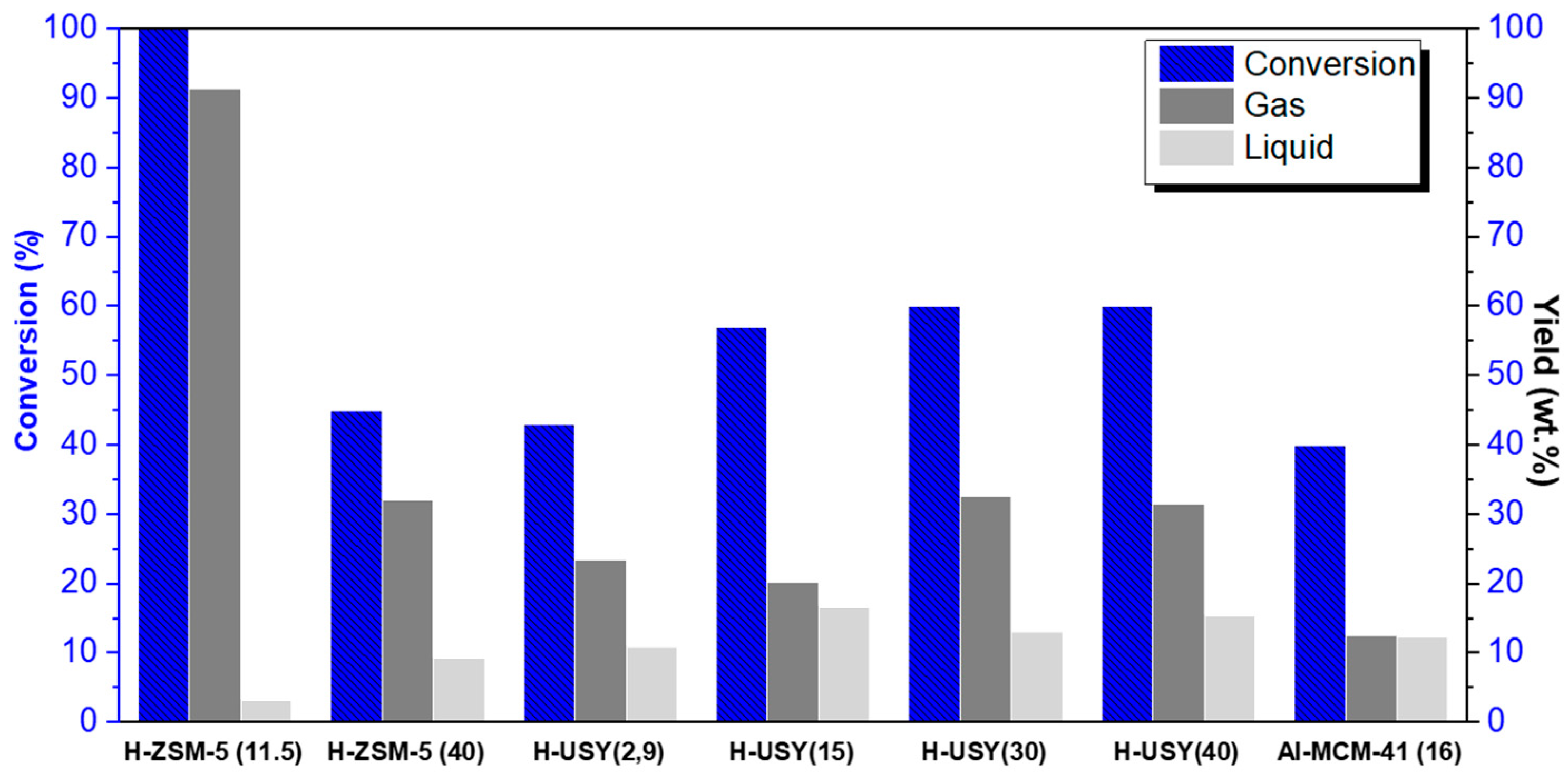
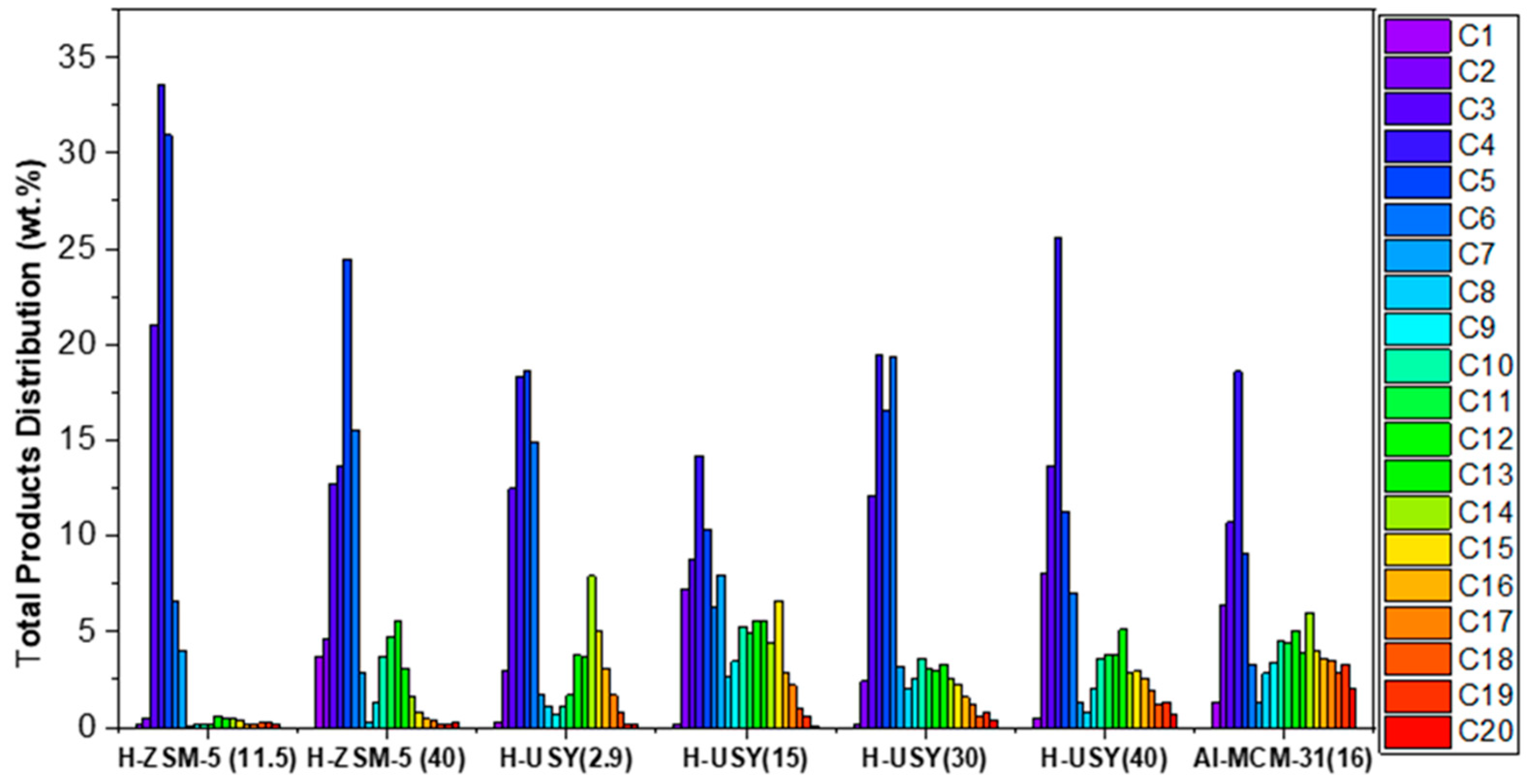
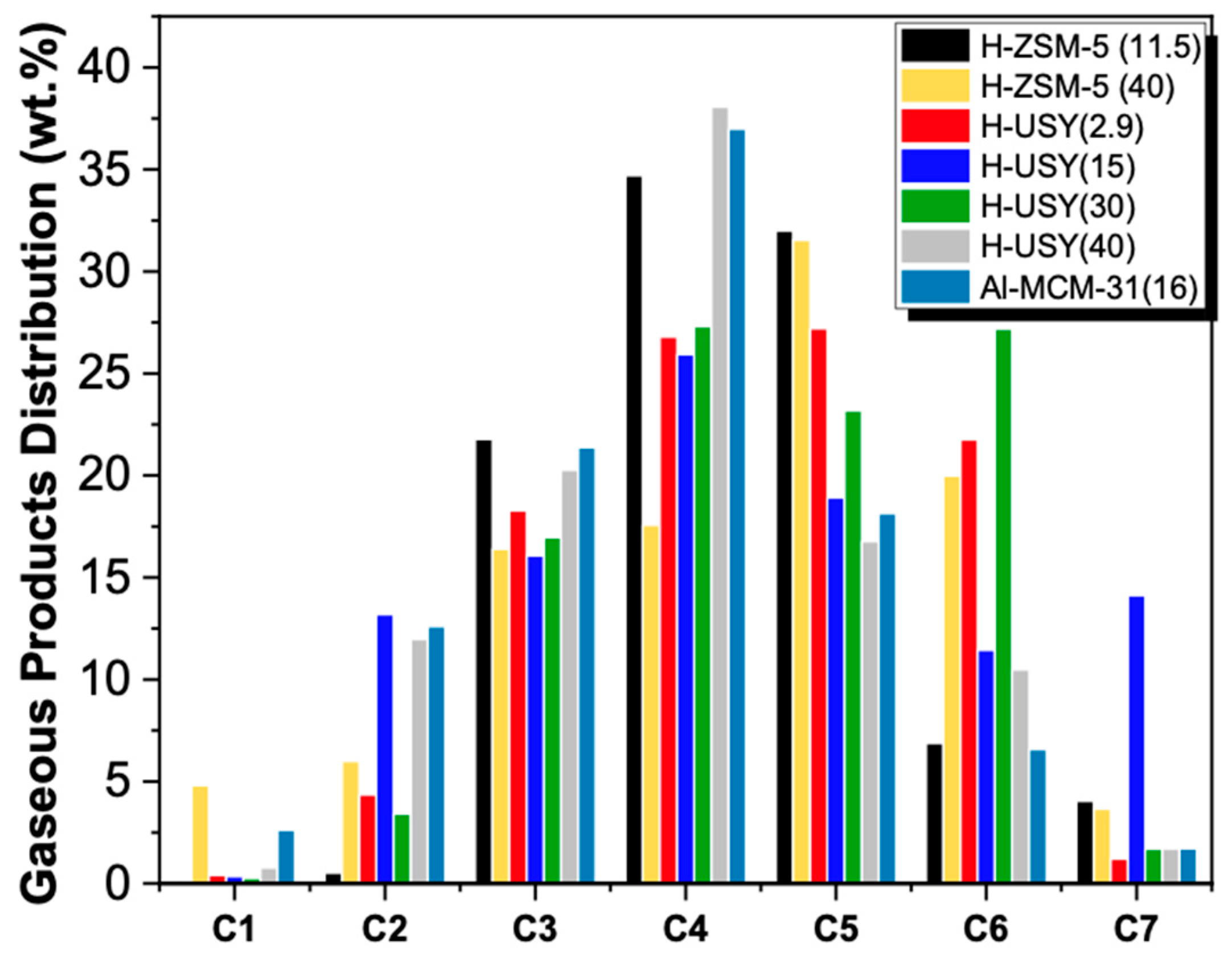
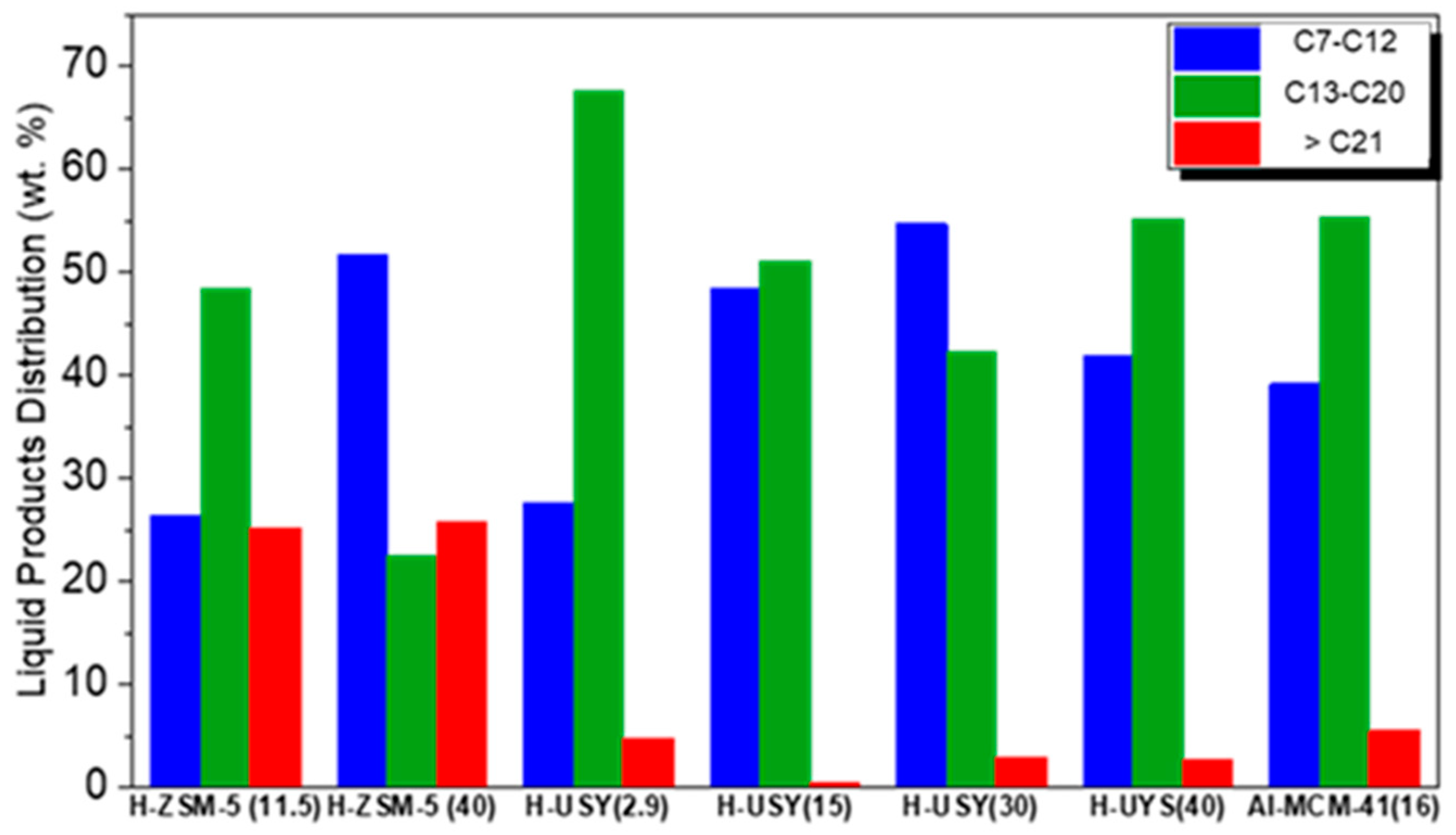

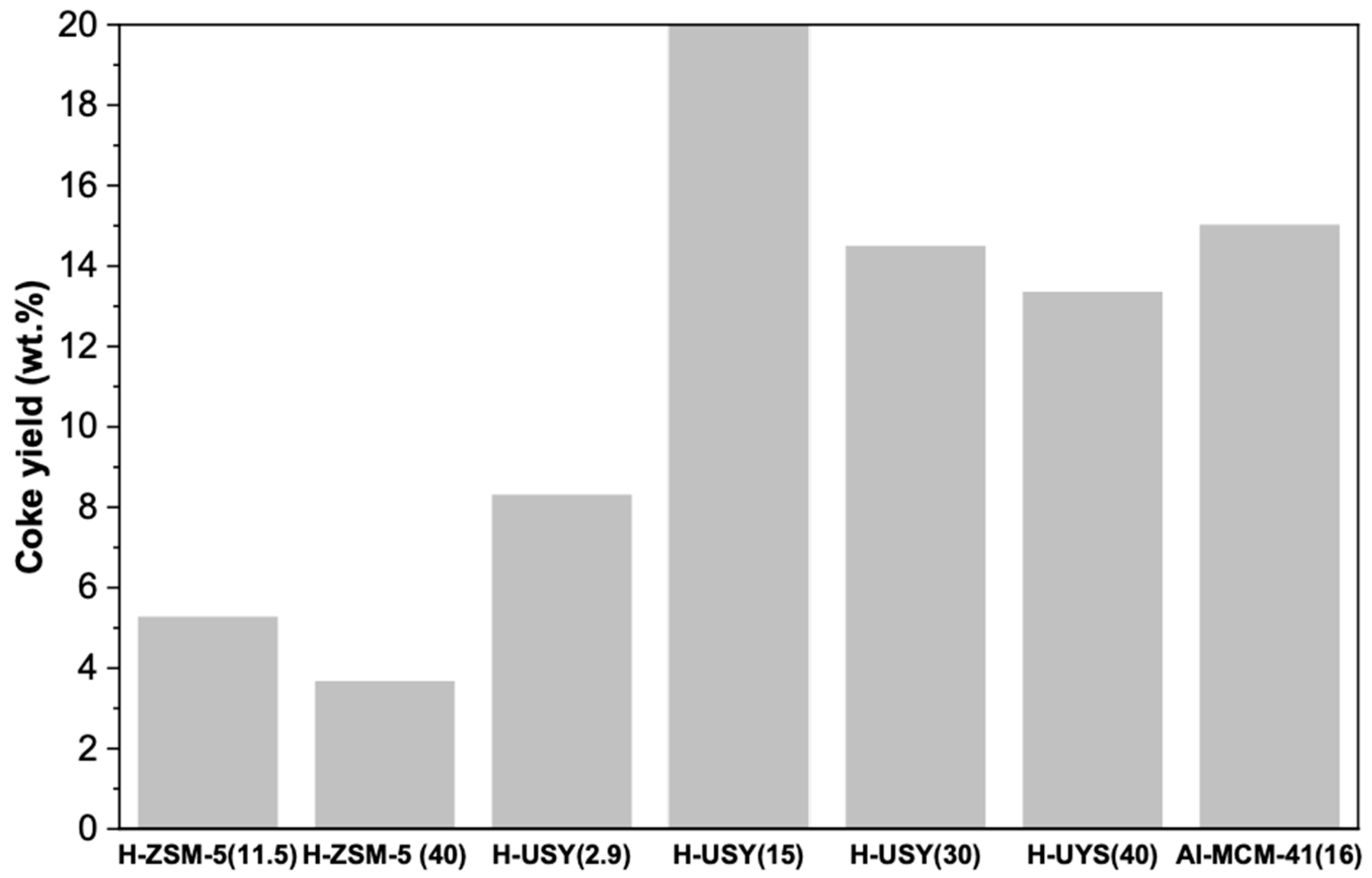
| Catalyst | SBET (m2/g) | Sext (m2/g) | Vmicro (cm3/g) | Vmeso (cm3/g) | Vtotal (cm3/g) | Φ meso (nm) | PyL (μmol/g) | PyH+ (μmol/g) | Total Acidity (μmol/g) | ||
|---|---|---|---|---|---|---|---|---|---|---|---|
| 150 °C | 350 °C | 150 °C | 350 °C | ||||||||
| Si-MCM-41 | 1007 | - | 0.0 | 0.85 | 0.85 | 3.4 | - | - | - | - | - |
| Al-MCM-41 (16) | 1092 | - | 0.0 | 0.82 | 0.82 | 3.3 | 232 | 159 | 113 | 8 | 345 |
| Al-MCM-41 (30) | 1047 | - | 0.0 | 0.87 | 0.87 | 3.0 | 162 | 117 | 86 | 33 | 248 |
| Ga-MCM-41 (63) | 734 | - | 0.0 | 0.63 | 0.63 | 3.4 | 13 | 3 | 0 | 0 | 13 |
| Ga-MCM-41 (82) | 1016 | - | 0.0 | 0.69 | 0.69 | 3.4 | 31 | 19 | 0 | 0 | 31 |
| H-USY (2.9) | - | 87 | 0.19 | 0.14 | 0.33 | - | 200 | 87 | 194 | 134 | 394 |
| H-USY (15) | - | 189 | 0.25 | 0.23 | 0.48 | - | 83 | 60 | 230 | 103 | 313 |
| H-USY (30) | - | 193 | 0.21 | 0.25 | 0.45 | - | 30 | 27 | 156 | 57 | 186 |
| H-USY (40) | - | 251 | 0.21 | 0.25 | 0.46 | - | 14 | 11 | 96 | 35 | 110 |
| H-ZSM-5 (11.5) | - | 114 | 0.13 | 0.10 | 0.23 | - | 111 | 89 | 649 | 384 | 760 |
| H-ZSM-5 (40) | - | 129 | 0.12 | 0.10 | 0.22 | - | 30 | 39 | 215 | 40 | 245 |
| H-ZSM-5 (500) | - | 75 | 0.11 | 0.07 | 0.18 | - | n.d. | n.d. | n.d. | n.d. | n.d. |
| Sample | T5% (°C) | T50% (°C) | T95% (°C) |
|---|---|---|---|
| HDPE | 433 | 478 | 488 |
| Si-MCM-41 | 431 | 474 | 468 |
| Al-MCM-41 (16) | 307 | 389 | 421 |
| Al-MCM-41 (30) | 420 | 455 | 471 |
| Ga-MCM-41 (63) | 429 | 466 | 480 |
| Ga-MCM-41 (82) | 428 | 470 | 488 |
| H-USY(2.9) | 290 | 378 | 406 |
| H-USY(15) | 271 | 370 | 410 |
| H-USY(30) | 249 | 340 | 382 |
| H-USY(40) | 270 | 357 | 399 |
| H-ZSM-5 (11.5) | 318 | 407 | 428 |
| H-ZSM-5 (40) | 338 | 405 | 422 |
| H-ZSM-5 (500) | 399 | 455 | 471 |
Disclaimer/Publisher’s Note: The statements, opinions and data contained in all publications are solely those of the individual author(s) and contributor(s) and not of MDPI and/or the editor(s). MDPI and/or the editor(s) disclaim responsibility for any injury to people or property resulting from any ideas, methods, instructions or products referred to in the content. |
© 2024 by the authors. Licensee MDPI, Basel, Switzerland. This article is an open access article distributed under the terms and conditions of the Creative Commons Attribution (CC BY) license (https://creativecommons.org/licenses/by/4.0/).
Share and Cite
Costa, C.S.; Ribeiro, M.R.; Silva, J.M. Catalyst Accessibility and Acidity in the Hydrocracking of HDPE: A Comparative Study of H-USY, H-ZSM-5, and MCM-41 Modified with Ga and Al. Molecules 2024, 29, 4248. https://doi.org/10.3390/molecules29174248
Costa CS, Ribeiro MR, Silva JM. Catalyst Accessibility and Acidity in the Hydrocracking of HDPE: A Comparative Study of H-USY, H-ZSM-5, and MCM-41 Modified with Ga and Al. Molecules. 2024; 29(17):4248. https://doi.org/10.3390/molecules29174248
Chicago/Turabian StyleCosta, Cátia S., M. Rosário Ribeiro, and João M. Silva. 2024. "Catalyst Accessibility and Acidity in the Hydrocracking of HDPE: A Comparative Study of H-USY, H-ZSM-5, and MCM-41 Modified with Ga and Al" Molecules 29, no. 17: 4248. https://doi.org/10.3390/molecules29174248
APA StyleCosta, C. S., Ribeiro, M. R., & Silva, J. M. (2024). Catalyst Accessibility and Acidity in the Hydrocracking of HDPE: A Comparative Study of H-USY, H-ZSM-5, and MCM-41 Modified with Ga and Al. Molecules, 29(17), 4248. https://doi.org/10.3390/molecules29174248






